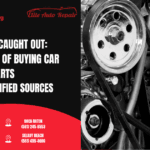A fresh repair job may look seamless initially, but without proper aftercare, you risk fading paint, peeling, or additional damage. Keeping your car looking brand new after a dent or scratch repair requires a bit of extra care In this articl we’ll walk you through essential aftercare tips to protect your investment and keep your car’s finish flawless.
Why Car Care After Repair Matters
Dents, scratches, and other minor damages can be frustrating, and while repairs can restore the look, it’s essential to maintain this finish afterward. Careless washing, exposure to harsh conditions, and lack of protection can lead to premature wear on the repaired area, especially when dealing with paint. With a few simple aftercare practices, you can prevent these issues and prolong the sleek look of your car.
1. Avoid Car Washes and Pressure Washing Right Away
1.1 Hold off on Automatic Washes
After a repair, it’s best to avoid commercial car washes for at least two weeks. The brushes and high-pressure jets in automatic car washes can damage freshly repaired areas, which may not have fully cured, and result in paint peeling or scratches.
1.2 Use Gentle Washing Techniques
Instead, wash your car by hand with a soft, non-abrasive sponge. Use gentle, circular motions and rinse with a low-pressure hose. This prevents damage to the paint while also helping you maintain control over the water pressure on your car.
2. Use High-Quality Car Care Products
2.1 Go for pH-Balanced Car Shampoo
Invest in a high-quality, pH-balanced car shampoo that won’t strip away the protective clear coat or damage freshly repaired paint. Harsh soaps and cleaners can harm a newly repaired surface, so mild and specialty car shampoos are recommended for safe washing.
2.2 Consider a Clay Bar for Added Protection
After a few weeks, consider using a clay bar to remove any impurities from the repaired surface. Clay barring can help smooth out minor imperfections and ensure the paint remains contaminant-free, making it look freshly polished.
3. Protective Measures in harsh weather conditions
3.1 Protect from Sun Exposure
Intense sun exposure can cause the color to fade or the repaired area to age prematurely. If possible, park your car in a shaded area or garage, especially during the first month post-repair. UV rays can affect the paint job, so it’s worth using a UV-protectant spray to preserve the paint’s vibrant finish.
3.2 Beware of Rain and Extreme Cold
Rain, snow, and even frost can impact fresh paint. Acidic rainwater and road salt are particularly harmful to newly repaired surfaces, leading to corrosion or paint degradation. Avoid parking outside during extreme weather when possible.
4. Accurate way of Applying Wax or Sealants
4.1 Let the Paint Cure
While waxing is typically a good way to protect car paint, wait about 60 days after the repair before applying any wax or sealant. Fresh paint needs time to cure, and applying wax too soon can trap contaminants or disrupt the curing process.
4.2 Apply a Quality Wax
After the waiting period, apply a high-quality car wax to the repaired area. Use a microfiber cloth to spread the wax evenly, protecting your paint while giving it a brilliant shine. This layer of protection is essential for safeguarding against UV rays, dirt, and minor abrasions.
5. Inspect the Repair Regularly
5.1 Check for Peeling or Fading
Take a few minutes every week to inspect the repaired area. Look for signs of peeling, fading, or bubbling, which could indicate improper adhesion or environmental damage. If you notice any issues, reach out to your repair technician for advice or follow-up services.
5.2 Address Minor Scratches Right Away
New scratches or nicks should be dealt with immediately to prevent them from deepening and causing further damage. Touch-up paint or protective sprays can help keep your car looking perfect and prevent damage from spreading.
6. Opt for Ceramic Coating for Long-Term Protection
6.1 What Ceramic Coating Does
For superior protection, consider getting a ceramic coating on your car. This layer creates a shield over your paintwork, making it resistant to minor scratches, fading, and contaminants. Although ceramic coatings involve an upfront investment, they can protect your car’s look for years.
6.2 Choose a Professional Application
DIY ceramic coatings are available, but for the best results on a freshly repaired area, a professional application is recommended. An expert will ensure the coating is applied evenly and doesn’t harm your car’s finish, giving it the long-term protection you need.
7. Drive Carefully to Prevent New Scratches or Dents
7.1 Avoid Gravel Roads
Gravel, debris, and rough roads can easily damage a newly repaired area. Try to avoid gravel or poorly maintained roads whenever possible to protect your car from rock chips and other abrasions.
7.2 Be Mindful in Parking Lots
Parking lots are hotspots for dings and dents. Choose parking spaces away from crowded areas, where other car doors or shopping carts are less likely to hit your vehicle.
Wind-Up
Taking care of your car after a dent or scratch repair is just as important as the repair itself. By following these steps, you can preserve your vehicle’s new look and keep it in pristine condition for years to come. Consistent maintenance and using the right products will protect the repair and maintain your car’s resale value.
We hope that this article helped you in learning the tips and procedures for maintaining your car after dent repairs. If you’re looking for expert car care advice or need help with your next repair, our team of automotive specialists is here to help!





